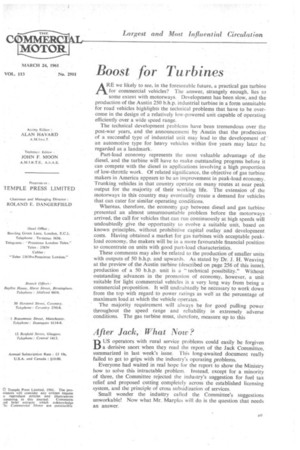Boost for Turbines
Page 43

If you've noticed an error in this article please click here to report it so we can fix it.
ARE we likely to see, in the foreseeable future, a practical gas turbine for commercial vehicles? The answer, strangely enough, lies to some extent with motorways. Development has been slow, and the production of the Austin 250 b.h.p. industrial turbine in a form unsuitable for road vehicles highlights the technical problems that have to be overcome in the design of a relatively low-powered unit capable of operating efficiently over a wide speed range.
The technical development problems have been tremendous over the post-war years, and the announcement by Austin that the production of a successful type of industrial unit may lead to the development of ' an automotive type for heavy vehicles within five years may later be regarded as a landmark.
Part-load economy represents the most valuable advantage of the diesel, and the turbine will have to make outstanding progress before it can compete with the diesel in applications involving a high proportion of low-throttle work. Of related significance, the objective of gas turbine makers in America appears to be an improvement in peak-load economy. Trunking vehicles in that country operate on many routes at near peak output for the majority of their working life. The extension of the motorways in this country may eventually create a demand for vehicles that can cater for similar operating conditions.
Whereas, therefore, the economy gap between diesel and gas turbine presented an almost unsurmountable problem before the motorways arrived, the call for vehicles that can run continuously at high speeds will undoubtedly give the opportunity to evolve a suitable unit, based on known principles, without prohibitive capital outlay and development costs. Having obtained a market for gas turbines with acceptable peakload economy, the makers will be in a more favourable financial position to concentrate on units with good part-load characteristics.
These comments may also be related to the production of smaller units with outputs of 50 b.h.p. and upwards. As stated by Dr. J. H. Weaving at the preview of the Austin turbine (described on page 256 of this issue), production of a 50 b.h.p. unit is a "technical• possibility." Without outstanding advances in the promotion of economy, however, a unit suitable for light commercial vehicles is a very long way from being a commercial proposition. It will undoubtedly be necessary to work down from the top with regard to power ratings as well as the percentage of maximum load at which the vehicle operates.
The majority requirement will always be for good pulling power throughout the speed range and reliability in extremely adverse conditions. The gas turbine must, therefore, measure up to this After Jack, i What Now?
BUS operators with rural service problems could easily be forgiven a derisive snort when they read the report of the Jack Committee, summarized in last week's issue. This long-awaited document really failed to get to grips with the industry's operating problems.
Everyone had waited in real hope for the report to show the Ministry how to solve this intractable problem. Instead, except for a minority of three, the Committee rejected the industry's suggestion for fuel tax relief and proposed cutting completely across the established licensing system, and the principle of cross subsidization of services.
Small wonder the indukry called the Committee's suggestions unworkable! Now what Mr. Marples will do is the question that needs an answer.




































































































































